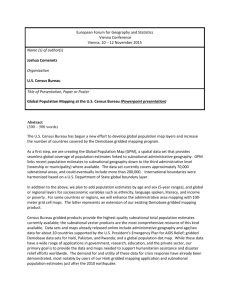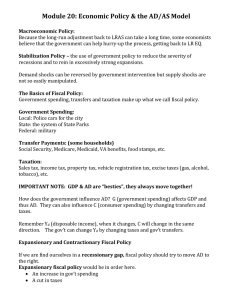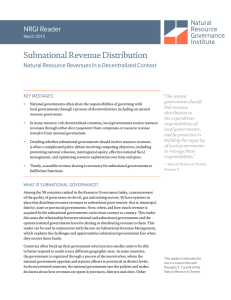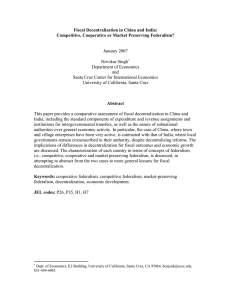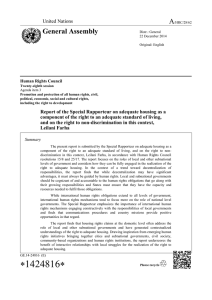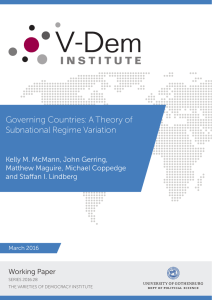Doing Business Differently with Subnationals: Recommendations for Global Health Donors in Highly
advertisement
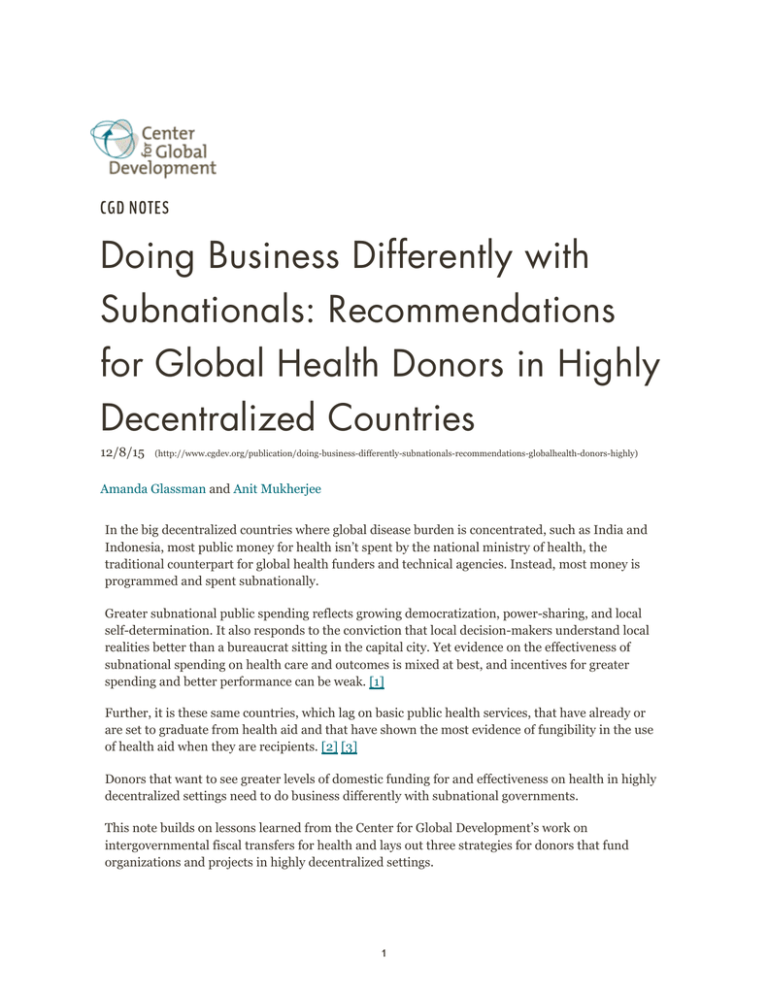
Configure CGD NOTES Doing Business Differently with Subnationals: Recommendations for Global Health Donors in Highly Decentralized Countries 12/8/15 (http://www.cgdev.org/publication/doing-business-differently-subnationals-recommendations-globalhealth-donors-highly) Amanda Glassman and Anit Mukherjee In the big decentralized countries where global disease burden is concentrated, such as India and Indonesia, most public money for health isn’t spent by the national ministry of health, the traditional counterpart for global health funders and technical agencies. Instead, most money is programmed and spent subnationally. Greater subnational public spending reflects growing democratization, power-sharing, and local self-determination. It also responds to the conviction that local decision-makers understand local realities better than a bureaucrat sitting in the capital city. Yet evidence on the effectiveness of subnational spending on health care and outcomes is mixed at best, and incentives for greater spending and better performance can be weak. [1] Further, it is these same countries, which lag on basic public health services, that have already or are set to graduate from health aid and that have shown the most evidence of fungibility in the use of health aid when they are recipients. [2] [3] Donors that want to see greater levels of domestic funding for and effectiveness on health in highly decentralized settings need to do business differently with subnational governments. This note builds on lessons learned from the Center for Global Development’s work on intergovernmental fiscal transfers for health and lays out three strategies for donors that fund organizations and projects in highly decentralized settings. 1 Recommended Strategies 1. Understand common pitfalls of fiscal transfers, then document the impact and political economy of current arrangements. Each country is unique, but the pitfalls that plague fiscal transfers and their usefulness for improving health are unfortunately common. Here are two examples: First, mismatches between funding quantities, health needs, and capacity to raise own revenues at subnational levels are evident in most large federal countries. This can result in structural inequities in health spending per capita with knock-on effects on inequities in service delivery and health impact. For example, in India, already a low health spender, there is a threefold difference between the highest- and lowest-spending states, [4] and a decade of ill-designed allocation formulae have not helped. When funds are earmarked for health by federal authorities, subnational entities can face difficulties in accessing and even spending their own money because of subnational capacity shortfalls or cash management practices that limit spending. [5] Second, where subnational governments have great autonomy in the allocation of resources, states’ budgets can fail to reflect central government priorities in health — or to even prioritize health at all. In Nigeria, for example, the central government fully subsidizes family planning commodities such as contraception, leaving states responsible for transport of contraceptives to health facilities. However, states such as the Cross River and Zamfara have not dedicated funds for this use.[6] Gaps like these between national and subnational budget line items are underdocumented, and their solution requires not only technical expertise but also understanding of and attention to the political economy of fiscal transfers and their design, as well as fiscal management practices. 2. Invest in data and accountability first, then advocacy. Donors frequently fund advocacy groups and activities in large, highly decentralized countries, hypothesizing that these efforts will help build political will and thereby increase domestic budgets to global health priorities. However, effective advocacy, as well as better health care, depend on robust data and analysis on how public budgets are formulated, transferred to, and used by subnational governments. In Kenya in 2013, for example, the budgets and management of regional hospitals — responsible for complicated births, emergency surgeries, and more complex HIV/AIDS treatment — were moved from the national ministry of health to county governments. Yet, following the policy change, not one advocacy group could explain how it affected service delivery in their area of interest because adequate tracking of spending and service delivery are mostly absent.[7] Donors should invest in data and evaluation first, and then in local government and civil society efforts to set priorities based on the best evidence and to track, publicize, and provide feedback on performance. 3. Expand subnational investments and incentives. All kinds of donors — from private foundations to multilateral institutions — have the capacity to interact directly with states and provinces, using grants, lending, and guarantees or innovative financing such as development impact bonds. This type of engagement, however, remains relatively 2 uncommon; only two programs of the Global Fund to Fight Aids, Tuberculosis and Malaria include subnational principal recipients in spite of the geographic concentration of their three focus diseases in countries where subnational governments are responsible for health services. Yet greater investment in and with subnational governments in middle-income countries has large potential pay-offs for improving health. For instance, donors could allocate resources to subnational governments according to the number (or share) of poor and/or make use of matching grants or other financial strategies tied to efficiency and performance in the health sector. The Bill and Melinda Gates Foundation’s Nigeria Governors’ Immunization Leadership Challenge is another possible strategy for expansion; the initiative provides prize grants for maintenance of polio vaccine coverage and seems to have created positive incentives to maintain efforts at the subnational level. Next Steps As more and more countries move towards a decentralized fiscal system, improving health outcomes will become ever more contingent on improving the efficiency and effectiveness of health spending at the subnational level. How donors do business particularly at the subnational level will also become increasingly important. As a first next step, donors must gain a better understanding of the fiscal architecture in the highly decentralized countries in which they work. Better knowledge of a country’s current arrangements and its impact on health can provide supporting evidence to do business differently — especially by expanding engagement, investments, and incentives to subnational governments. A 2015 report by CGD and the Accountability Initiative at the Center for Policy Research in New Delhi, which explores India’s fiscal and health policies, is one example of the type of analysis that could be useful for donors. The report takes a careful look at the performance of public financing policy reforms and offers recommendations for how fiscal transfers could be leveraged to improve health, and what roles donors could take moving forward. Ultimately, global health donors have an opportunity to have a big impact if they shift their business model to accommodate the changing fiscal landscape. They must seek to gain a better understanding of the political economy of large, decentralized countries’ fiscal architectures, make data and evaluation a primary investment, and expand investments and incentives to subnational governments. [1] A Glassman and Y Sakuma (2014) “Intergovernmental Fiscal Transfers for Health: Overview Framework and Lessons Learned,” available at: http://bit.ly/1CeUAXs. [2] A Glassman (2014) “Health Aid Eligibility and Country Income Status: A Mismatch Mishap?” available at: http://bit.ly/1jvwzAn. [3] S Dykstra, A Glassman, et al. (2015) “The Impact of Gavi on Vaccination Rates: Regression Discontinuity Evidence,” available at: http://bit.ly/1HRTPjC; C Lu, T Schneider, et al. (2010) 3 “Public financing of health in developing countries: a cross-national systematic analysis,” Lancet, 375(9723): 1375–1387. [4] MG Rao and M Choudhury (2011) “Health Care Financing Reforms in India,” available at: http://bit.ly/1PhpikR. [5] V Fan, S Iyer, et al. (2015) “Review of Inter-Governmental Fiscal Transfers for Health: Lessons Learned and Looking Ahead,” available at: http://bit.ly/1NdHcYl. [6] D Dickerson and AA Ahmed (2013) “Advocacy for Family Planning: Understanding the Budget Process in Two Nigerian States — Cross River and Zamfara,” available at: http://bit.ly/1NARkr7. [7] Personal communication: Jason Lakin, International Budget Project (March 2015). 4
